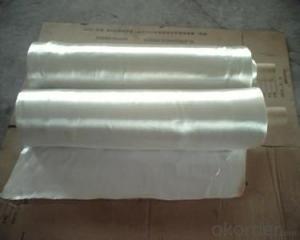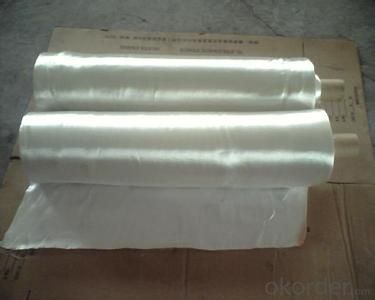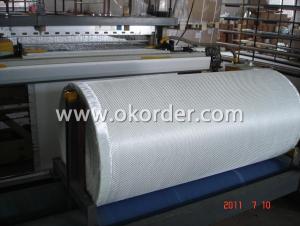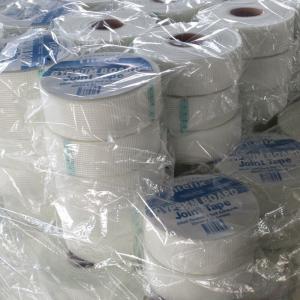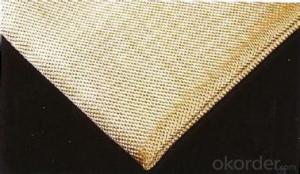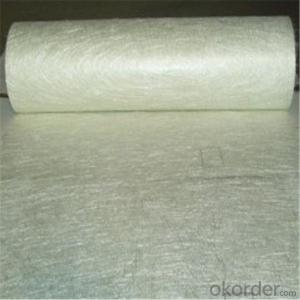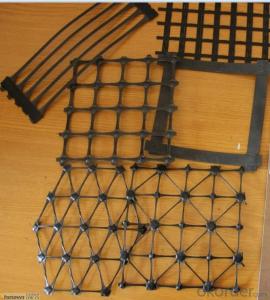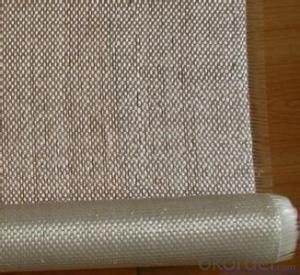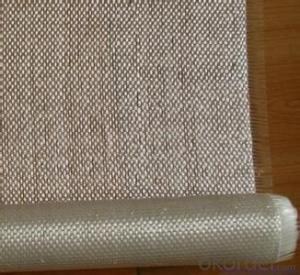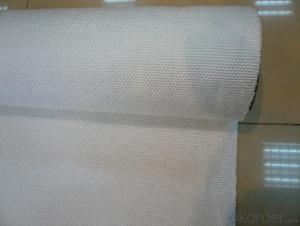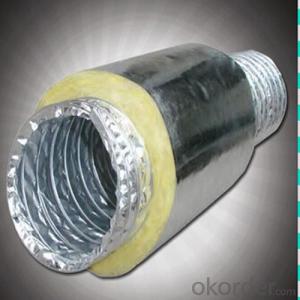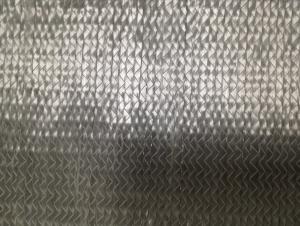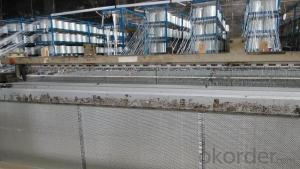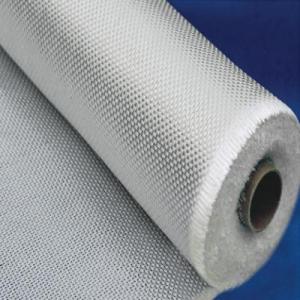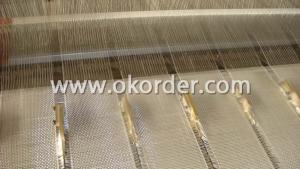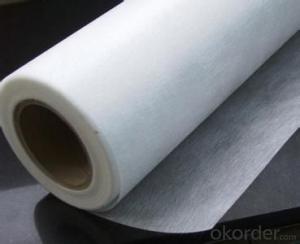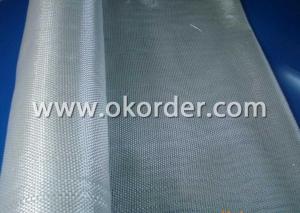Italian Supplier High Silica Fiberglass Fabrics Insulation Aluminum Foil
- Loading Port:
- China Main Port
- Payment Terms:
- TT OR LC
- Min Order Qty:
- -
- Supply Capability:
- -
OKorder Service Pledge
Quality Product, Order Online Tracking, Timely Delivery
OKorder Financial Service
Credit Rating, Credit Services, Credit Purchasing
You Might Also Like
Quick Details
| Type: | Place of Origin: | Brand Name: | |||
| Model Number: | name: |
Packaging & Delivery
| Packaging Detail: | inner roll, outer bag |
| Delivery Detail: | 15-20days |
Specifications
insulation aluminum foil high silica fiber glass cloth
1.Professional microfibre manufacture
2,OEM&ODM is welcome
- Q: Can fiberglass fabrics be used for insulation in refrigeration systems?
- Yes, fiberglass fabrics can be used for insulation in refrigeration systems. Fiberglass is a common material used for insulation due to its excellent thermal properties. It is a lightweight and durable material that can effectively resist heat transfer, making it suitable for insulating refrigeration systems. Additionally, fiberglass fabrics can be easily molded or shaped to fit the specific needs of the refrigeration system, ensuring a proper and tight insulation. It is also resistant to moisture, which is important in refrigeration systems where condensation can occur. Overall, fiberglass fabrics are a reliable choice for insulating refrigeration systems and are commonly used in the industry.
- Q: Can fiberglass fabric be used for reinforcement in 3D printing?
- Yes, fiberglass fabric can be used for reinforcement in 3D printing. It is commonly used to add strength and durability to printed objects, especially those that require enhanced mechanical properties. The fiberglass fabric can be embedded within the printed layers to provide reinforcement and improve the overall structural integrity of the printed part.
- Q: How do fiberglass fabrics perform in terms of moisture wicking?
- Fiberglass fabrics lack the typical ability to wick away moisture. Unlike fabrics made from natural fibers like cotton or wool, fiberglass fabrics do not possess inherent moisture-wicking capabilities. This is mainly because fiberglass is non-absorbent, making it difficult for moisture to be absorbed and carried away from the skin. However, it is worth noting that fiberglass fabrics can still be utilized in certain applications where moisture management is not the main concern. Fiberglass is commonly chosen for its exceptional mechanical properties, including high strength, durability, and resistance to heat, chemicals, and fire. Therefore, in industries such as automotive, aerospace, and construction, fiberglass fabrics are selected based on these advantageous characteristics rather than their ability to wick away moisture. In situations where moisture management is vital, other fabric options that possess moisture-wicking capabilities are generally preferred. Fabrics like polyester, nylon, or blends with natural fibers like cotton or bamboo are known for their ability to absorb moisture and transport it away from the body, ensuring the wearer stays dry and comfortable. To conclude, although fiberglass fabrics may not provide significant moisture-wicking properties, they are still widely used in various industries due to their numerous other advantageous characteristics.
- Q: How is fiberglass fabric cleaned?
- Fiberglass fabric can be cleaned by first removing any loose debris or dirt with a soft brush or vacuum cleaner. Then, mix a mild detergent with warm water and gently scrub the fabric using a sponge or soft cloth. Rinse thoroughly with clean water and allow it to air dry. Avoid using harsh chemicals or abrasive materials that may damage the fiberglass fabric.
- Q: Can fiberglass fabric be used for making protective sleeves and gloves?
- Yes, fiberglass fabric can be used for making protective sleeves and gloves.
- Q: What type of thread is used for sewing fiberglass fabric?
- Polyester thread, referred to as the commonly used thread for sewing fiberglass fabric, is specifically engineered to possess strength and durability. This makes it well-suited for stitching heavy and resilient materials such as fiberglass. With its elevated tensile strength, it effectively withstands abrasion, a crucial quality when handling stiff and abrasive fiberglass fabric. Moreover, polyester thread exhibits resistance to both UV rays and chemicals, rendering it perfect for outdoor and industrial applications that frequently involve fiberglass fabric.
- Q: Can fiberglass fabric be used for insulation in steam systems?
- No, fiberglass fabric is not suitable for insulation in steam systems as it does not have the necessary heat resistance to withstand high temperatures.
- Q: What industries commonly use fiberglass fabrics?
- Fiberglass fabrics possess exceptional properties and versatility, making them commonly utilized in various industries. Some industries that frequently employ fiberglass fabrics include: 1. Automotive Industry: The automotive sector heavily relies on fiberglass fabrics for the production of different components like car bodies, bumpers, hoods, and interior parts. The lightweight nature and high strength-to-weight ratio of fiberglass fabrics are ideal for enhancing fuel efficiency, overall performance, and durability. 2. Aerospace Industry: Fiberglass fabrics find numerous applications in the aerospace industry, particularly in the manufacturing of aircraft components. They are utilized in constructing wings, fuselages, rotor blades, and other structural elements. The strength, ability to withstand extreme temperatures, and low weight of fiberglass fabrics make them suitable for aerospace applications. 3. Construction Industry: The construction sector widely utilizes fiberglass fabrics for reinforcing concrete structures. Fiberglass-reinforced polymers (FRP) are commonly employed to enhance the strength, durability, and crack resistance of concrete elements like beams, columns, and slabs. Additionally, fiberglass fabrics are used in roofing materials, insulation, and as reinforcement in wallboards. 4. Marine Industry: The marine industry extensively relies on fiberglass fabrics due to their exceptional resistance to corrosion, water, and UV rays. They are employed in the production of boat hulls, decks, and other structural parts. The lightweight yet robust solutions provided by fiberglass fabrics make them highly suitable for various marine applications. 5. Sports and Recreation Industry: Many manufacturers of sports and recreational equipment utilize fiberglass fabrics in their products. Fiberglass fabrics are commonly found in sporting goods such as surfboards, kayaks, paddleboards, and skis. Their strength, flexibility, and impact resistance make them a popular choice in this industry. 6. Chemical and Industrial Applications: Fiberglass fabrics possess high resistance to chemicals, making them essential in industries dealing with corrosive substances. They are used in the production of chemical storage tanks, pipes, and ducts. Additionally, fiberglass fabrics are employed for insulation in thermal and electrical applications, including electronic equipment and furnaces. Overall, the remarkable properties of fiberglass fabrics enable them to have a wide range of applications across various industries. Their high strength, lightweight nature, resistance to corrosion, and versatility establish them as a preferred material for countless industrial and commercial uses.
- Q: How does fiberglass fabric handle mold and mildew?
- Fiberglass fabric is highly resistant to mold and mildew growth. This is primarily due to its composition and properties. Unlike organic materials such as cotton or wool, fiberglass is made from inorganic materials, mainly glass fibers. These glass fibers are tightly woven together to create a strong and durable fabric. One of the key reasons why fiberglass fabric is resistant to mold and mildew is its non-porous nature. Mold and mildew thrive in moist environments, and organic materials provide a suitable food source for them. However, fiberglass fabric does not absorb moisture, making it difficult for mold and mildew to grow. Additionally, the smooth surface of fiberglass fabric does not provide crevices or areas for mold spores to settle and grow. Furthermore, fiberglass fabric is often treated with a special coating during the manufacturing process. This coating adds an extra layer of protection against mold and mildew. It acts as a barrier, preventing moisture from penetrating the fabric and inhibiting the growth of mold and mildew. However, it is important to note that although fiberglass fabric is highly resistant to mold and mildew, it is not entirely immune. If the fabric is exposed to prolonged periods of high humidity or damp conditions, there is still a slight possibility for mold and mildew to develop. Regular cleaning and maintenance, along with keeping the fabric dry and well-ventilated, can help prevent any potential growth. Overall, fiberglass fabric's non-porous nature, smooth surface, and often applied protective coating make it an excellent choice for environments where mold and mildew resistance is a concern. Its resistance to these types of growths contributes to its longevity and durability, making it a preferred material for various applications such as insulation, protective clothing, and construction materials.
- Q: Is fiberglass fabric resistant to pests in agricultural settings?
- In agricultural settings, fiberglass fabric exhibits resistance against pests. It is unappealing to insects, rodents, and birds due to its composition. Its sleek and impermeable surface poses challenges for pests in search of sustenance, refuge, or materials for nesting. Consequently, they are deterred from inhabiting or causing harm to the fabric. Moreover, fiberglass fabric does not succumb easily to rot, decay, or moisture absorption, thereby minimizing the probability of pest infestation. This renders it a highly favorable option for agricultural environments that prioritize pest management to safeguard crops and uphold a sound ecosystem.
Send your message to us
Italian Supplier High Silica Fiberglass Fabrics Insulation Aluminum Foil
- Loading Port:
- China Main Port
- Payment Terms:
- TT OR LC
- Min Order Qty:
- -
- Supply Capability:
- -
OKorder Service Pledge
Quality Product, Order Online Tracking, Timely Delivery
OKorder Financial Service
Credit Rating, Credit Services, Credit Purchasing
Similar products
Hot products
Hot Searches
Related keywords
